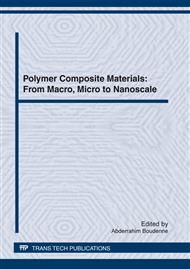p.229
p.237
p.245
p.255
p.263
p.271
p.277
p.283
p.291
In Vitro Degradation of β-Tricalcium Phosphate Reinforced Poly(L-Lactic Acid)
Abstract:
Poly (L-lactic acid) (PLLA) and composite of PLLA with osteoconductiveβ-tricalcium phosphate fine powder (PLLA/TCP) compression moulded specimens were subjected to in vitro biodegradation up one year. Samples were investigated in terms of physical-chemical evaluation after several periods of incubationin simulated body fluid solution. Reduction in PLLA molecular weights occurred during thermal processing of compounding of the polymer with TCP. 3-point bending measurements revealed some decay in the flexural strength and increase in stiffness after incorporation of the inorganic particles into the polymer. Those parameters remained nearly stable during the biodegradation period despite constant drop of polymer molecular weight. Thermal properties of both kinds of samples did not changed significantly, however degree of crystallinity of PLLA matrix was increasing slowly in pure PLLA samples. Despite no mass loss,extent of surface deteriorationincreased steady during the incubation. Current study is intended to develop material for implants, mainly fusion cages targeted for spinal applications.
Info:
Periodical:
Pages:
283-290
Citation:
Online since:
March 2012
Authors:
Keywords:
Price:
Сopyright:
© 2012 Trans Tech Publications Ltd. All Rights Reserved
Share:
Citation:


